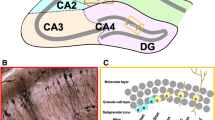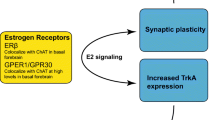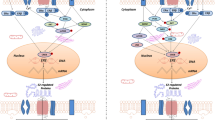Abstract
Evidence that estrogen protects neurons against toxic/ischemic insults or degenerative/aging processes is evident in a variety of in vitro and in vivo systems. However, a critical remaining question is: Does the demonstrated morphologic and neurochemical protection by estrogen lead to a preservation of brain function or an enhanced ability to recover? To date, little basic research is available on this issue. Cognition is a critical function that might provide a sensitive way to examine this question. As a first step, we present results showing that two chronic environmental insults, psychoactive drugs and stress, produce gender-specific responses in cognitive abilities. Specifically, females appear less sensitive than males to cognitive impairments following chronic exposure to these factors. Results are presented in male and female rats utilizing cognitive tests that assess visual (object recognition) and spatial memory (object placement and radial arm maze) following chronic amphetamine, methamphetamine, or daily restraint stress. Following regimes of chronic stress or amphetamine, males were impaired on these tasks while females were either unaffected, less affected, or enhanced in performance. These observations suggest that differences in circulating gonadal hormone levels between the sexes may contribute to the differential sensitivity of the sexes and provide endogenous neuroprotection for females. Surprisingly, ovariectomized females were still not impaired following a stress regimen that impaired males (21 d of daily restraint). These data taken together with neurochemical data on estrogen neuroprotective effects indicate that it is possible that neuroprotection by estrogen may result from hormone action both during sexual differentiation (organizational effect) and in adulthood (activational effect). These considerations and possible unwanted/untoward effects of chronic estrogen use are discussed in relation to the use of selective estrogen receptor modulators for chronic treatment of both males and females. In conclusion, although compelling evidence for neuroprotection by estrogen has been presented in anatomic and neurochemical studies, it is clear that the functional/behavioral aspects need further investigation.
Similar content being viewed by others
References
Matsumoto, A. (1991). Psychoneuroendocrinology 16, 25–40.
Dohanich, G. (2002). In: Hormones, brain and behavior. Pfaff, D. W., Arnold, A. P., Etgen, A. M., Fahrbach, S. E., and Rubin, R. T. (eds.). Academic: New York.
Sherwin, B. B. (2002). Trends Pharmacol. Sci. 23(11), 527–534.
Henderson, V. W. (1997). Neurology 48(S7), S27-S35.
Garcia-Segura, L. M., Azcoitia, I., and DonCarlos, L. L. (2001). Prog. Neurobiol. 63, 29–60.
Wise, P. M., Dubal, D. B., Wilson, M. E., Rau, S. W., Bottner, M., and Rosewell, K. L. (2001). Brain Res. Rev. 37(1–3), 313–319.
Lannert, H., Wirtz, P., Schuhmann, V., and Galmbacher, R. (1998). J. Neuroal Transm. 105, 1045–1063.
Dluzen, D. E. and McDermott, J. L. (2002). Ann. NY Acad. Sci. 965, 136–156.
Sawada, H., Ibi, M., Kihara, T., et al. (2002). Neuropharmacology 42, 1056–1064.
Luine, V. N. (2002). Stress 5(3), 205–216.
McEwen, B. (2002). Recent Prog. Horm. Res. 57, 357–384.
Mizoguchi, K., Kunishita, T., Chui, D. H., and Tabra, T. (1992). Neurosci. Lett. 138, 157–160.
Robinson, T. E. and Kolb, B. (1997). J. Neurosci. 21, 8491–8497.
Camp, D. M. and Robinson, T. E. (1988). Behav. Brain. Res. 30(1), 69–88.
Becker, J. B. and Beer, M. E. (1986). Neurosci. Lett. 23, 203–208.
Alexander, G. E., Crutcher, M. D., and DeLong, M. R. (1990). Prog. Brain Res. 85, 119–146.
Nestler, E. G. (2001). Nature 2, 119–128.
Viaud, M. D. and White, N. M. (1989). Behav. Brain Res. 32, 31–42.
Packard, M. G., Cahill, L., and McGaugh, J. L. (1994). Proc. Natl. Acad. Sci. USA 91, 8477–8481.
Harper Mozley, L., Gur, R. C., David Mozley, P., and Gur, R. E. (2001). Am. J. Psychiatry 158, 1492–1499.
Bisagno, V., Ferguson, D., and Luine, V. (2003). Pharmacol. Biochem. Behav. 74, 859–867.
Quinones-Jenab, V., Perrotti, L., Fabian, S., Chin, J., Russo, S., and Jenab, S. (2001). Ann. NY Acad. Sci. 937, 140–171.
Roth, M. E., Larson, E. B., and Carroll, M. E. (2002). Drug Alcohol Depend. 66, S2-S202.
Ennaceur, A. and Delacour, J. (1988). Behav. Brain Res. 31, 47–59.
Beck, K. D. and Luine, V. N. (1999). Brain Res. 830, 56–71.
Miller, D. B., Ali, S. F., O’Callaghan, J. P., and Laws, S. C. (1998). Ann. NY Acad. Sci. 844, 153–165.
Bisagno, V., Ferguson, D., and Luine, V. (2002). Brain Res. 940, 95–101.
Mumby, D. G., Gaskin, S., Glenn, M. J., Schramek, T. E. and Lehmann, H. (2002). Learning Memory 9, 49–57.
Ennaceur, A., Neave, N., and Aggleton, J. P. (1997). Exp. Brain Res. 113, 509–519.
Cancela, L. M., Basso, A. M., Martijena, I. D., Capriles, N. R., and Molina, V. A. (2001). Brain Res. 309, 179–186.
Wallace, T. L., Gudelsky, G. A., and Vorhees, C. V. (1999). J. Neurosci. 19, 9141–9148.
Friedman, S. D., Castaneda, E., and Hodge, G. K. (1998). Pharmacol. Biochem. Behav. 61, 35–44.
Volkow, N. D., Chang, L., Wang, G. J., et al. (2001). Am. J. Psychiatry 158, 377–382.
Simon, S. L., Domier, C., Carnell, J., Brethen, P., Rawson, R., and Ling, W. (2000). Am. J. Addict. 3, 222–231.
McKetin, R. and Mattick, R. P. (1997). Drug Alcohol Depend. 48, 235–242.
Ornstein, T. J., Iddon, J. L., Baldacchino, A. M., et al. (2000). Neurospychopharmacology 23, 113–116.
Luine, V., Beck, K., Bowman, R. and Kneavel, M. (2001). In: Neuroplasticity, development and steroid hormone action. Handa, R. J., Hayaski, S., Terasawas, E., and Kawata, M. (eds.). CRC Press: Boca Raton, FL.
Bowman, R. E., Beck, K., and Luine, V. N. (2003). Horm. Behav. 43, 48–59.
Watanabe, Y., Gould, E., and McEwen, B. S. (1992). Brain Res. 588, 341–345.
Luine, V. and Rodriguez, M. (1994). Behav. Neural Biol. 62, 230–236.
Bowman, R. E., Zrull, M. C., and Luine, V. N. (2001). Brain Res. 904, 279–289.
Beck, K. D. and Luine, V. N. (1999). Brain Res. 830, 56–71.
Beck, K. D. and Luine, V. N. (2002). Physiol. Behav. 75, 661–673.
Luine, V., Martinez, C., Villegas, M., Magarinos, A. M., and McEwen, B. S. (1996). Physiol. Behav. 59, 27–32.
Luine, V., Villegas, M., Martinez, C., and McEwen, B. S. (1994). Brain Res. 639, 167–170.
Vongher, J. M. and Frye, C. A. (1999). Pharmacol. Biochem. Behav. 64(4), 777–785.
Hovartz, K. M., Hartig, W., Van Der Veen, R., et al. (2002). Neuroscience 110(3), 489–504.
Jacobs, D. M., Tang, M. X., Stern, Y., et al. (1998). Neurology 50(2), 368–373.
Cyr, M., Landry, M., and Di Paolo, T. (2000). Neuroendocrinology 23(1), 69–78.
Landry, M., Levesque, D., and Di Paolo, T. (2002). Neuroendocrinology 76(4), 214–222.
Cyr, M., Ghribi, O., Thibault, C., Morissette, M., Landry, M., and Di Paolo, T. (2001). Brain Res. Rev. 37, 153–161.
Callier, S., Morissette, M., Grandbois, M., Pelaprat, D., and Di Paolo, T. (2001). Synapse 41(2), 131–138.
Grandbois, M., Morissette, M., Callier, S., and Di Paolo, T. (2000). Neuroreport 7(11), 343–346.
Lacreuse, A., Wilson, M. E., and Herndon, J. G. (2002). Neurobiol. Aging 23, 589–560.
Author information
Authors and Affiliations
Corresponding author
Rights and permissions
About this article
Cite this article
Bisagno, V., Bowman, R.E. & Luine, V.N. Functional aspects of estrogen neuroprotection. Endocr 21, 33–41 (2003). https://doi.org/10.1385/ENDO:21:1:33
Received:
Revised:
Accepted:
Issue Date:
DOI: https://doi.org/10.1385/ENDO:21:1:33




